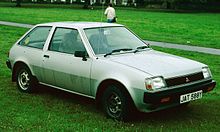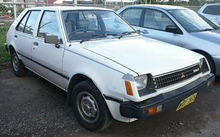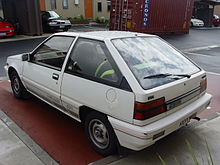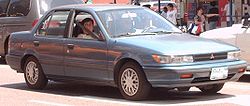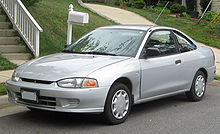- Mitsubishi Mirage
-
Mitsubishi Mirage 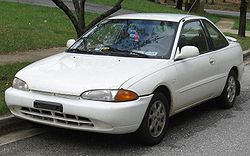
Manufacturer Mitsubishi Motors Production 1978–2002 Successor Mitsubishi Lancer Class Subcompact The Mitsubishi Mirage is a subcompact car produced by Mitsubishi Motors from 1978 to 2002. It was also sold as the Mitsubishi Colt or Lancer Fiore.
In North America, compact vehicles from Mitsubishi derived from the Mirage or Lancer lineage were sold under the Mirage name from 1985 to 2001, as Chrysler owned the right to the Lancer name, with the Dodge Lancer. When DaimlerChrysler briefly controlled Chrysler and Mitsubishi, the Lancer name was given to Mitsubishi for usage in North America.
Contents
First generation (1978-1982)
First generation 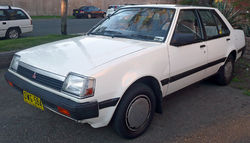
Also called Mitsubishi Colt Production 1978–82
(Australia to 1990)Assembly Nagoya plant, Okazaki, Aichi, Japan
Tonsley Park, Adelaide, Australia
Todd Park, Porirua, New ZealandBody style 3-door hatchback
4-door sedan
5-door hatchbackLayout FF layout Mitsubishi launched the Mirage as a three-door front wheel drive hatchback in 1978, as a response to the first fuel crisis some years before. It had a distinctive design with large windows and Mitsubishi's Super Shift transmission (four speeds, but two modes). A five-door joined the range in 1979. This version of the Mirage was exported to the United States as the Dodge Colt and Plymouth Champ from 1979 and received the highest United States Environmental Protection Agency fuel economy rating that year.
A 1600 cc engine joined the range in 1979.
In 1981, the Lancer Fiore, not to be confused with the regular Mitsubishi Lancer, was launched. The Fiore was a four-door version of the Mirage. At the same time, the range was facelifted.
In 1982, a turbocharged, 105 PS (77 kW) version of the 1400 cc engine was made available.
In many countries, this car was known as the Mitsubishi Colt. In the United Kingdom, where Colt was the marque, it was called the Colt 1200 and Colt 1400, after the size of the engines, which it shared with the larger Lancer.
Since most overseas markets did not have the Minica kei car, the Mirage was the entry-level model.
Local CKD assembly of the Mirage took place in New Zealand by Todd Motors, where there was a sports equivalent called the Mirage Panther in the early 1980s. The replacement Mirage Turbo had the distinction of being that country's second locally assembled turbocharged car from 1983, following the Lancer Turbo.
The facelifted model was also built by Mitsubishi of Australia, and had an unusually long model life, from 1981 to 1990. The Australians offered the Colt with the 1.4 L engine, and a larger 1.6 L. This model was imported for a short time to New Zealand in the late 1980s, where it was sharing showroom space with the locally assembled third generation models.
Second generation (1983-1987)
Second generation 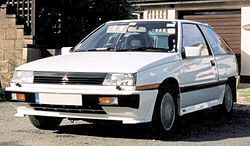
Production 1983–1987 Assembly Kurashiki, Okayama, Japan Body style 3-door hatchback
4-door sedan
5-door hatchback
5-door station wagonLayout Front engine, front-/four-wheel drive Mitsubishi launched a new Colt in 1983, still splitting the range into Mirage (three- and five-door hatchback) and Lancer Fiore (four-door sedan) models, though some export markets did sell the four-door as the Mirage. A station wagon was added in 1985 and a four-wheel-drive wagon in 1986.
Engine power for the 4G32BT engine for the USDM "Turbo Sport" model, was 105 horsepower; the 3 door hatchback Turbo Sport weighted in at a low 2005 USDM pounds.
Many export markets sold the hatchbacks as the Mirage or Colt, and the sedan and station wagon as the Lancer.
A commercial version of the wagon was sold in New Zealand as the Mitsubishi Express, replacing an earlier model based on the Mitsubishi Galant Sigma.
New engines were added: the 1300 and 1500 cc engines replaced the 1200 and 1400; an 1800 cc diesel was also added.
The Mirage was not sold in the United States by Mitsubishi until 1985, and it was this version that made the marque's début there.
The four-door model formed the basis of the Proton Saga, Malaysia's first locally built car. Proton would spin the Saga off into a five-door hatchback (styled differently from Mitsubishi's own five-door hatch version) called the Saga Aeroback in 1987.
Versions available
The Mirage was available in Europe as the Mitsubishi Colt, and the following versions were offered:
- 1200 EL/GL 3-door
- 1300 GL 3/5-door
- 1500 GLX 3/5-door
- 1800 GL Diesel 5-door
The Lancer saloon was available in the same trim levels as the hatchback model (but not with the 1200 engine), while the estate versions were available as 1500 GLX and 1800 GLD only.
Australia got only the 1300 GL and 1500 GLX versions.
Third generation (1987-1992)
Third generation Production 1987–1992 Assembly Nagoya plant, Okazaki, Aichi, Japan
Normal, IllinoisBody style 3-door hatchback
4-door sedan
5-door hatchbackLayout FF layout Engine 1.5 L 81 hp (60 kW) I4 Transmission 3-speed automatic
4-speed manual
5-speed manualWheelbase Hatchback: 2,385 mm (93.9 in)
Sedan: 2,455 mm (96.7 in)Length Hatchback: 4,030 mm (158.7 in)
Sedan: 4,320 mm (170.1 in)Width 1,670 mm (65.7 in) Height Hatchback: 1,320 mm (52.0 in)
Sedan: 1,340 mm (52.8 in)Curb weight 915 kg (2,020 lb) The 1987 third-generation Mirage was stylistically distinct: Mitsubishi had scored well with its revamped Galant and transferred its styling to the smaller cars. The basic model was a three-door with an upright tailgate. The top Mirages in Japan were called the Mirage Cyborg, featuring a turbocharged 1600 cc engine developing 145 PS (107 kW).
Engines available were 1.3 and 1.5 12-valve 4-cylinder engines, and 1.6 and 1.8 16-valve 4-cylinder engines. European versions were available in 1300 GL, 1500 GLX, 1600 GTi, 1800 GTi 16v versions. In some markets a 'van' model was produced, being the three-door hatchback without rear side windows (attracting a reduced sales tax in the Dutch market).
Four-door models were usually called Lancer overseas, but Mirage in Japan and North America. In Australia, all the models in this range were badged Mitsubishi Lancer.
The 1989–92 model year Mirage was also sold as the Dodge/Plymouth Colt (as a hatchback) and the Eagle Summit in the US. In Canada, the Mirage sedan that time was known as the Dodge/Plymouth Colt, because Mitsubishis weren't sold in Canada up until the 2003 model year.
The Mirage Turbo was on Car and Driver's Ten Best list for 1989.
The station wagon was carried over, as there never was a wagon made on the third generation Mirage chassis.
Face lift
The Mirage and Lancer received a facelift in 1990, with late models receiving the same engines as were seen in the next generation Mirage/Colt/Lancer.
These were known as the 'CB' chassis in Australia and New Zealand.
Fourth generation (1991-1996)
Fourth generation 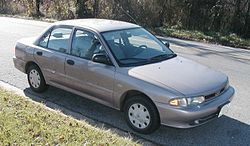
Production 1991–1996 Assembly Kurashiki, Okayama, Japan
Normal, IllinoisBody style 3-door hatchback
4-door sedan
2-door coupeLayout Front engine, front-/four-wheel drive Engine 1.5 L 92 hp (69 kW) I4
1.6 L 172 hp (128 kW) I4 (MIVEC)
1.8 L 131 hp (98 kW) I4Transmission 3-speed automatic
4-speed automatic
5-speed manualWheelbase 2,500 mm (98.4 in)
Coupe: 2,440 mm (96.1 in)Length 4,375 mm (172.2 in)
Coupe: 4,345 mm (171.1 in)Width 1,690 mm (66.5 in)
Coupe: 1,680 mm (66.1 in)Height 1,325 mm (52.2 in)
Coupe: 1,310 mm (51.6 in)Curb weight 946 kg (2,090 lb) In 1991 the 4th Generation or 'CC' chassis platform changed to a modern more stylish rounder shape to its predecessors. A two-door coupe was introduced based on the Mirage (the Asti in Japan) and sold outside Japan to a number of countries around the world as the 'CC' chassis Mirage (in New Zealand and United States), and the Lancer coupe in Australia. These deliveries mainly saw a Front wheel drive 1500cc 8 valve SOHC caburettor engine in the base GL model, or a 1800 cc SOHC 8 valve EFI engine in the higher GLXi variant in Australia, and the same engines were offered in New Zealand and overseas but in a choice of either Front Wheel Drive or All wheel drive variant, and either a 2-door, 3-door (Cyborg) or 4-door shape. This is where the first MIVEC 1600 cc engines started to roll out in Mitsubishi platforms. The 2 door CC coupe was sold with the CA5A chassis description. Mitsubishi's engine choices were vast with this new platform. Their most popular were the 4G15 1.5 Carburetor, 4G15 1.5 fuel injected, 4G93 1.8 EFI, 4G93 1.8 DOHC EFI, 4G92 1.6 MIVEC EFI, a 4G91 1.5 DOHC caburetor, and even a 6A10 (V6)and 4D68 Turbo Diesel all in either a front wheel drive or All Wheel Drive format. The 2.0L 4G63 turbo was an option only in the United States, but was quickly dropped in favor of using this power option in the soon to be released Lancer Evolution I.
Proton took over the license to this design for its range from 1997 onwards and it is still offered in some countries as the Proton Satria (three-door, ex Cyborg) and Proton Wira (four and five-door), Proton M21/Putra coupe (2-door), or 200 and 400 series. Not only is the car still being built by Proton, but they also developed a pickup/ute variant of the chassis and named it the Proton Jumbuck.
Mitsubishi started manufacturing the fourth generation/CC platform in 1992, it was taken over by Proton in 1996/97 and is still being utilised in 2006.
With the split between the name Asti/Mirage/Lancer namesake spanning over several countries it created somewhat of a confusion but something that all models share is the 'CC' chassis platform. The rounder shape of the Asti/Mirage/Lancer coupe, hatch and 4 door sedan gave them a modern sportier appearance different from the squarer 'CC' chassis of the Mirage/Lancer sold alongside it in the showroom floor. These squarer 4th Generation versions of the Lancer/Mirage sedan and wagon (as pictured to the right) had the similar appearance as the popular Evolution Lancer 1-3 models which were used in rally. These models were available in sedan or wagon and either FWD or AWD. A 1800 cc DOHC Turbo 145 kW (197 PS; 194 hp) version of the Lancer Sedan was sold as the "GSR Turbo" variant in Australia and New Zealand, and the AWD turbo wagon was only available in New Zealand under the "Libero" name. These versions were based on the EVO 1-3 models, but only offered with a 1800 cc 4G93T turbo engine, not the 1998 cc 4G63T turbo engine as in the EVO models.
Fifth generation (1997-2002)
Fifth generation 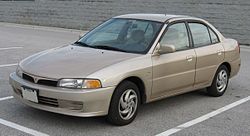
Production 1997–2002 Assembly Mizushima plant, Kurashiki, Okayama, Japan
Normal, IllinoisBody style 3-door hatchback
4-door sedan
4-door wagon
2-door coupeLayout FF layout Engine 1.5 L 92 hp (69 kW) I4
1.6 L 172 hp (128 kW) I4 (MIVEC)
1.8 L 113 hp (84 kW) I4Transmission 4-speed automatic
5-speed manualWheelbase Sedan: 2,500 mm (98.4 in)
Coupe: 2,415 mm (95.1 in)Length Sedan: 4,410 mm (173.6 in)
Coupe: 4,270 mm (168.1 in)Width 1,690 mm (66.5 in) Height 2000-02 Coupe: 1,360 mm (53.5 in)
2000-01 Sedan: 1,390 mm (54.7 in))
1997-99 Sedan: 1,335 mm (52.6 in)
1997-99 Coupe: 1,305 mm (51.4 in)Curb weight 1,045 kg (2,300 lb) A new Mirage was launched in 1995 and called the 'CE'ALEpillo or 5th Generation chassis. The range was rationalized to a two-door coupe (still called Mirage Asti in Japan), three-door hatchback and a four-door sedan, all but the three-door being called Lancer in export markets. A station wagon on this platform was offered but never as a Mirage, in either Japan or overseas. In Japan it had Libero badges. It is usually considered part of the Lancer lineage, not the Mirage one.
By 2003, the only Mirage sold in Japan was the coupé, without the Asti designation.
Due to Mitsubishi's financial troubles, this version of the Mirage stayed in production to 2003, with minor facelifts along the way. Despite a new Lancer (the Lancer Cedia) in 2000, many countries (including Thailand and New Zealand) still sold this generation as late as 2003. The United States, which sold the range as the Mirage from 1997 to 2002, replaced it with the Lancer Cedia (called plain Lancer there and in all other export markets) from 2002.
With the rising popularity of boxy compact and subcompact SUVs in Japan, the Mirage nameplate was used on a domestic market-only model called the Mirage Dingo, from 1999. The Dingo was facelifted in 2001 and cancelled in 2003.
However, New Zealand sold a very different Mirage in 2002: a rebadged, Dutch-made Mitsubishi Space Star. The vehicle was not very popular and was soon discontinued.
Most countries replaced the Mirage with the Mitsubishi Colt, sharing a platform with the Smart Forfour, in 2004.
Sixth generation (2012)
The Colt will be renamed back to Mirage in 2012. The sixth generation was previewed as a concept car at the 2011 [Geneva Auto Show]] and will be unveiled at the 2011 Tokyo Motor Show. Following the Nissan Micra, the Mirage will have simpler design and mechanic. The car will be built in Thailand.
At launch, the only engine with will be a 1.0L 3-cylinder naturally aspirated gasoline with start-stop, coupled with a continuously variable transmission.
External links
Mitsubishi Motors North America timeline Type 1980s 1990s 2000s 2010s 0 1 2 3 4 5 6 7 8 9 0 1 2 3 4 5 6 7 8 9 0 1 2 3 4 5 6 7 8 9 0 1 Subcompact Cordia Tredia Mirage Mirage Mirage Precis Compact Mirage Lancer Lancer Galant Galant Sigma Galant Diamante Sport compact Eclipse Eclipse Eclipse Eclipse Lancer Evolution Lancer Evolution Mid-size Galant Galant Diamante Diamante Sports car Starion 3000GT Station wagon Space Wagon Expo Expo LRV Compact XUV Outlander Outlander Outlander Sport/RVR Mid-size XUV Endeavor Minivan Vanwagon Sport utility vehicle Montero Sport Montero Montero Montero Pickup Mighty Max Mighty Max Raider L200 Categories:- Mitsubishi Motors vehicles
- Subcompact cars
- 1970s automobiles
- 1980s automobiles
- 1990s automobiles
- 2000s automobiles
- Vehicles introduced in 1978
- Front wheel drive vehicles
- All wheel drive vehicles
Wikimedia Foundation. 2010.

